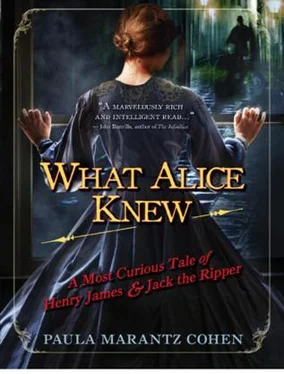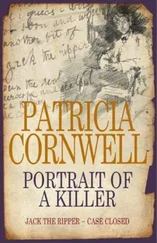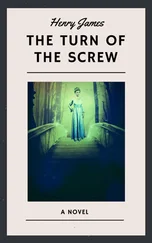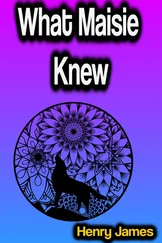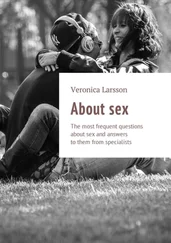“Most certainly,” William agreed encouragingly. “We know Sickert was fond of performing music hall songs for his friends. Dressing in female garb of that sort was par for the course for him.”
Abberline nodded. This idea seemed to him of more importance than anything else he had heard. He tended to look at things from a practical standpoint. Where an alibi existed, it was useless to concoct a theory. But where there was no alibi, or an alibi destroyed, then one could begin to do some work.
There had been plenty of circumstantial evidence to link Sickert to the murders if one wanted that. As William had noted earlier, his notepaper was watermarked Pirie and Sons, the mark on some of the alleged Ripper notes. And then there were his paintings—they had been of precisely the sort of women that had been killed. Indeed, several of the subjects in his “music hall series,” as he had referred to them flippantly during interrogation, had resembled in age and physical appearance the murdered women. And there were his studios in the East End, providing ample opportunity for the man to know the area and to be known, so as not to elicit suspicion.
But Abberline had not given any of this much credence. He had learned from experience how easily a person could be led in the wrong direction based on predisposition and circumstantial evidence. William’s insistence on Sickert’s guilt had struck him as too adamant and therefore likely to be influenced by emotional factors irrelevant to the case. So long as Sickert had an alibi, he existed outside the realm of suspicion.
But things had now changed. Sickert’s alibi had proven to be less than sound, and as a result, what had previously been dismissed now seemed freighted with meaning. Abberline did not quarrel with his colleague this time but hurried to gather his men and send them in pursuit of their suspect.
William returned to Alice’s flat to find his brother and sister sitting together. He knew that neither was convinced of Sickert’s guilt and was thus prepared to be patient with them in discussing the case. But before he could speak, Henry motioned excitedly to him to approach the bed.
“I have a delicate question to ask you,” he said, glancing conspiratorially at Alice. “Popular wisdom has it that self-abuse causes insanity. Do you agree?”
William looked at his brother with surprise and exasperation. “This is neither the time nor the place to discuss your personal neuroses.”
Henry waved his hand. “This has nothing to do with me. It pertains to the case.”
William looked puzzled but responded, “The enlightened medical view is that the act of self-pleasuring is natural enough if there are no other outlets for such urges. Although anything to excess bears looking into,” he added with his usual tendency to caution. “Still, I can’t see what relevance this could possibly have—”
“Then where did the theory come from?” Alice intervened.
“From the fact that we stigmatize children and young people for the act, and the trauma that results can have lasting pathological effects. It’s a common logical fallacy of reversed cause and effect. But again, I can’t see—”
“Lasting pathological effects!”
“Did Sickert abuse himself?”
“Not Sickert,” said Alice, for whom everything had now become clear. “Henry just visited Legros, who told him that not long before Sickert left, a student named Peter Newsome was expelled from the Slade. He was caught abusing himself after a life-drawing class. Whistler took him on and then let him go when he found he could no longer draw. That’s the ‘pupil of Whistler’ we should be looking for.”
“Another ‘pupil of Whistler’?” said William. “But you’re forgetting the room and the bonnet on the floor. We’ve established that the murderer of Mary Jane Kelly had to have seen your bedroom. Only Sickert was here.”
“It’s true that only Sickert saw the room,” said Alice quietly, “but you are concentrating on the wrong element. It’s the mistake you just mentioned…what did you call it? ‘A logical fallacy of reversed cause and effect.’”
“I don’t follow,” said William.
Alice and Henry looked at each other as though enjoying the uncharacteristic slowness of their brother. “Don’t you see? The murderer didn’t have to see the room…if he saw the painting.”
The statement struck William with the force of a blow. As always, when he got something wrong, he felt how narrow and stupid he had been. He had forgotten the primary factor necessary in solving any human problem: the element of motive. There had never been one with Sickert, just an array of contributing circumstances and a desire on his own part to find the man guilty. He felt shame for his stupidity, but also for his excessive emotional involvement in the case; the former had followed directly from the latter. One became stupid when emotion blocked reason.
But now, Alice’s news had had an amazingly equilibrating effect. The sense of feverish excitement he had felt only moments before had receded, and he felt he could see plainly for the first time in a while.
“Did Sickert show your painting to anyone after he finished it?” he asked Alice. His voice had returned to the calm, measured tone of the academic researcher.
“I’ve been considering that,” she responded. “I’m sure he didn’t show it in any general way. He said he didn’t like a portrait to be seen before it was framed.”
“But did he frame it himself?”
“ That is the key,” she agreed. “I don’t know, but he did say the picture would be framed by the time he returned from Cornwall. He didn’t go to Cornwall, as it happens, but I do think he dropped it off somewhere for the purpose.”
“We know that he used someone to do his framing,” piped in Henry. “I recall he was late to my dinner party because he was waiting for a framed painting to be delivered. He said he had gone to school with the framer.”
William nodded. He had already known that the theory would be confirmed. He had accepted it at once, as soon as Alice had uttered it. It was that way with a scientific truth: one tried and tried to understand how something in nature worked, and then once one did, the process became entirely evident, as transparent as glass.
The atmosphere in the room had changed; the sense of disagreement and distrust had evaporated. For a moment, William felt great exhilaration, less regarding the case than because of the sense of reunion with his brother and sister. It was as though his family, long fractured, had been repaired.
William seated himself on the edge of the bed, Henry drew his chair closer, and Alice leaned forward so that their heads were almost touching. Calmly and carefully they pieced the thing together. A young man named Peter Newsome, studying under Alphonse Legros at the Slade, was caught abusing himself after a drawing lesson. He was thrown out of the school and shamed terribly. Whistler took him on as an apprentice. But the trauma affected the boy’s mental state, which in turn affected what was most important to him: his art. He could no longer draw. To make a living, he resorted to framing pictures, since it was something he could do, yet he continued to try to paint. Meanwhile, Sickert became the new “pupil of Whistler.” He had met Newsome at the Slade; perhaps they even overlapped in their apprenticeships. In any case, Sickert employed his colleague to frame his work, and that work became a source of envy and frustration to Newsome. Whenever he saw one of Sickert’s paintings, it reminded him of his earlier promise and prompted him to attempt something similar. Polly Nichols posed for him because Sickert had recently painted a woman of Polly’s general appearance and profession. There was the music hall sketch in Sargent’s studio, no doubt preliminary to a series of paintings in that line. The other victims reflected the same impulse.
Читать дальше
